
Once upon a time there was a poor college student, a decent young man, but awkward and unlucky. One evening a beautiful goddess appeared before him and offered to grant him a single wish. He could have anything he wished for, no matter how outrageous, but he must choose carefully because he would not be given a second chance.
Impulsively and incautiously, he wished that she would stay with him…
-
Original TitleAa Megami-sama
-
GenresFantasy, Comedy, Romance
-
DemographicSeinen
-
Contents26 Episodes on 6 DVDs
-
LanguagesEnglish, Japanese with subtitles
-
Based onA manga by Kosuke Fujishima
-
DirectorHiroaki Gohda
-
StudioAIC
-
BroadcastTBS, 2005
-
Region 1 PublisherAnimeWorks
…And thus begins one of the most popular manga series of all time, one that has been running continuously since 1989. There have been a number of anime adaptations over the years; this television series is the latest.
This is a charming comedy with likable main characters and clever, whimsical fantasy elements. How much you like it may depend on what you are comparing it to. If you think of it as “the Japanese version of Bewitched” you will probably like it very much; it is at least an order of magnitude better than the American television series to which it is sometimes compared.
Parental Advisory
This is not written for children but probably won’t harm them. Parents of younger children may still have reason for concern. It contains mild sexual humor and sexual situations (but no nudity) and cartoon violence. The most problematic issue is repeated depictions of excessive alcohol consumption by secondary characters [1].
Premise and Characters
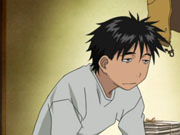 Keiichi Morisato is an engineering student at the Nekomi Institute of Technology, which is apparently located somewhere in the Tokyo area. He is woefully lacking in self-confidence and is constantly bossed around by the older students.
Keiichi Morisato is an engineering student at the Nekomi Institute of Technology, which is apparently located somewhere in the Tokyo area. He is woefully lacking in self-confidence and is constantly bossed around by the older students.
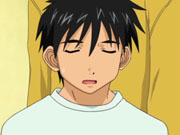 But he’s a nice guy and he has a talent for fixing things. He has quite of collection of obsolete electronic equipment that he has salvaged from the trash and lovingly restored. He particularly likes cars and motorcycles, which led him to join the Nekomi Motor Club, a decision that he must sometimes regret.
But he’s a nice guy and he has a talent for fixing things. He has quite of collection of obsolete electronic equipment that he has salvaged from the trash and lovingly restored. He particularly likes cars and motorcycles, which led him to join the Nekomi Motor Club, a decision that he must sometimes regret.
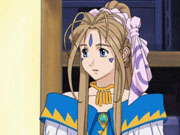 Belldandy (Goddess First Class, Category 2, Unlimited License) [2] never expected to end up stuck on Earth with a human being, but she’s far too conscientious to even think about failing to grant a wish. Fortunately she’s the sort of person who always looks on the bright side of things (in fact her ability to do this is downright inhuman.) She doesn’t know much about how humans live, but she discovers that most of it is absolutely delightful–even the things that most humans find tedious and unpleasant. And while Keiichi may seem like a loser, she thinks he has real potential.
Belldandy (Goddess First Class, Category 2, Unlimited License) [2] never expected to end up stuck on Earth with a human being, but she’s far too conscientious to even think about failing to grant a wish. Fortunately she’s the sort of person who always looks on the bright side of things (in fact her ability to do this is downright inhuman.) She doesn’t know much about how humans live, but she discovers that most of it is absolutely delightful–even the things that most humans find tedious and unpleasant. And while Keiichi may seem like a loser, she thinks he has real potential.
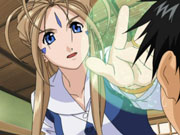 Belldandy seems nice but she’s not perfect. She’s sweet, kind and unfailingly polite, but when she does get angry Heaven and Earth will tremble. She sets extremely high standards for herself and gets upset if she fails to live up to them, even in trivial ways. She is naive about humans and often seems overly trusting [3].
Belldandy seems nice but she’s not perfect. She’s sweet, kind and unfailingly polite, but when she does get angry Heaven and Earth will tremble. She sets extremely high standards for herself and gets upset if she fails to live up to them, even in trivial ways. She is naive about humans and often seems overly trusting [3].
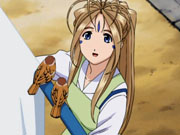 Belldandy dislikes violence but she enjoys most nonviolent forms of competition, especially races, and there’s not much point in playing against her in a game of chance. She rarely eats human food but she loves drinking tea.
Belldandy dislikes violence but she enjoys most nonviolent forms of competition, especially races, and there’s not much point in playing against her in a game of chance. She rarely eats human food but she loves drinking tea.
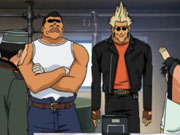 Tamiya (L) and Ootaki (R) are the leaders of the Nekomi Motor Club and take every opportunity to boss Keiichi around. They don’t really mean any harm by it; they seem to have some notion that they are going to make a man of him. (If they don’t kill him first.) They helpfully come up with a scheme to perform some quick computer hacking to enroll Belldandy as a transfer student.
Tamiya (L) and Ootaki (R) are the leaders of the Nekomi Motor Club and take every opportunity to boss Keiichi around. They don’t really mean any harm by it; they seem to have some notion that they are going to make a man of him. (If they don’t kill him first.) They helpfully come up with a scheme to perform some quick computer hacking to enroll Belldandy as a transfer student.
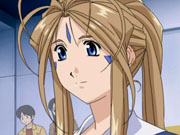 Fortunately most people are pretty unobservant where goddesses are concerned. Everyone is quite willing to accept that Belldandy is a foreign student from some unspecified country where the people are blonde and blue-eyed and have blue marks on their faces.
Fortunately most people are pretty unobservant where goddesses are concerned. Everyone is quite willing to accept that Belldandy is a foreign student from some unspecified country where the people are blonde and blue-eyed and have blue marks on their faces.
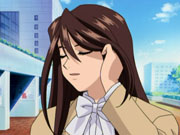 Sayoko Mishima, the daughter of a wealthy industrialist, was the most popular girl on campus until Belldandy showed up and started to attract a lot of male attention. Furious that anyone would challenge her status, she vows to find a way to make Belldandy go back where she came from.
Sayoko Mishima, the daughter of a wealthy industrialist, was the most popular girl on campus until Belldandy showed up and started to attract a lot of male attention. Furious that anyone would challenge her status, she vows to find a way to make Belldandy go back where she came from.
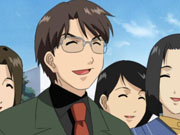 Sayoko’s cousin Toshiyuki Aoshima is a ruthless Lothario. Sayoko encourages him to pursue Belldandy.
Sayoko’s cousin Toshiyuki Aoshima is a ruthless Lothario. Sayoko encourages him to pursue Belldandy.
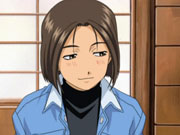 Like her older brother, Megumi Morisato intends to pursue an engineering career. She is more self-confident than Keiichi and likes to tease him, but deep down she trusts and respects him. She and Belldandy become good friends but she carefully ignores any supernatural phenomena that happen around her; that’s just not something that she wants to deal with.
Like her older brother, Megumi Morisato intends to pursue an engineering career. She is more self-confident than Keiichi and likes to tease him, but deep down she trusts and respects him. She and Belldandy become good friends but she carefully ignores any supernatural phenomena that happen around her; that’s just not something that she wants to deal with.
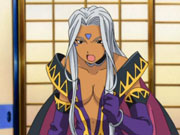 Belldandy’s older sister Urd (Goddess Second Class, Category 1 (Administration), Limited License [4]) is sultry, vulgar, cynical and irresponsible. As children she and Belldandy were very close, but the relationship now seems strained. The fact that she is a Second Class Goddess has more to do with her personality defects than with a lack of power; she is a skilled spell-caster who specializes in potions and weird medicines. Her primary job in Heaven is to administer Yggdrasil, a gigantic computer that connects the various worlds and which may have been used to create them [5]. She doesn’t care for tea, but will consume great quantities of sake.
Belldandy’s older sister Urd (Goddess Second Class, Category 1 (Administration), Limited License [4]) is sultry, vulgar, cynical and irresponsible. As children she and Belldandy were very close, but the relationship now seems strained. The fact that she is a Second Class Goddess has more to do with her personality defects than with a lack of power; she is a skilled spell-caster who specializes in potions and weird medicines. Her primary job in Heaven is to administer Yggdrasil, a gigantic computer that connects the various worlds and which may have been used to create them [5]. She doesn’t care for tea, but will consume great quantities of sake.
 Goddesses want humans to be happy. Demons, naturally enough, want humans to be unhappy [6]. For Marller (Demon First Class, Unlimited License) the fact that goddesses are hanging around Keiichi is a real problem. They’re creating too much happiness, just by their presence on Earth. She is determined to make them go back where they belong.
Goddesses want humans to be happy. Demons, naturally enough, want humans to be unhappy [6]. For Marller (Demon First Class, Unlimited License) the fact that goddesses are hanging around Keiichi is a real problem. They’re creating too much happiness, just by their presence on Earth. She is determined to make them go back where they belong.
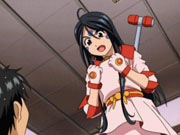 Belldandy’s younger sister Skuld (Goddess Second Class, Limited License) can be very cute and appealing. Sometimes we can see that she is insecure and vulnerable. However most of the time she is just a brat. She worships Belldandy and fights constantly with Urd, but deep down she is really closer to Urd (Belldandy is a bit too perfect and unapproachable.)
Belldandy’s younger sister Skuld (Goddess Second Class, Limited License) can be very cute and appealing. Sometimes we can see that she is insecure and vulnerable. However most of the time she is just a brat. She worships Belldandy and fights constantly with Urd, but deep down she is really closer to Urd (Belldandy is a bit too perfect and unapproachable.)
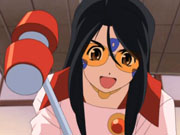 Her magic powers are very limited but she has great technical skills and can turn ordinary household objects into fantastic high-tech inventions, often with some disastrous flaw. Her main job is Heaven is to help keep Yggdrasil running properly; she is shown here holding a debugging tool. She is able to eat incredible amounts of ice cream. Whatever you do, don’t call her a “kid”. When angry she throws bombs.
Her magic powers are very limited but she has great technical skills and can turn ordinary household objects into fantastic high-tech inventions, often with some disastrous flaw. Her main job is Heaven is to help keep Yggdrasil running properly; she is shown here holding a debugging tool. She is able to eat incredible amounts of ice cream. Whatever you do, don’t call her a “kid”. When angry she throws bombs.
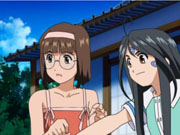 Sora Hasegawa, the youngest member of the Motor Club, is very shy and insecure.
Sora Hasegawa, the youngest member of the Motor Club, is very shy and insecure.
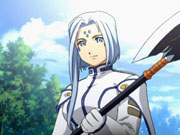 Lind (Goddess First Class, Category 3, Unlimited License) is a Valkyrie or warrior goddess. She is normally called in to deal with imminent threats to the security of Heaven.
Lind (Goddess First Class, Category 3, Unlimited License) is a Valkyrie or warrior goddess. She is normally called in to deal with imminent threats to the security of Heaven.
DVD Notes
One thing some people criticize about the manga is that it doesn’t have much of a plot; it’s a slice of life, a sequence of events in the lives of a goddess and her human companion. The television writers rearranged the order of events to give the first season a recognizable story arc with a dramatic climax. The DVDs somewhat spoil the effect by adding two minor unbroadcast episodes after the climax.
The first DVD has two amusing extras: a promotional appearance by seiyuu Kikuko Inoue (Belldandy) and an omake in which the voice actors explain the various forms of magic used in the series. The latter gives a hint of how much the people involved in the production love this story.
Other Versions
Ah! My Goddess, Season 2
(Aa Megami Sama, Sorezore no Tsubasa or Ah! My Goddess! All the Wings) The second season of the TV series has been licensed by ADV Media, but is not yet available in North America.
Ah! My Goddess The Motion Picture
The movie, released in 2000, is probably more faithful to the manga than any of the other anime adaptations. However it is set very late in the story, later than the manga’s current position, and may even be thought of as providing a logical end to it. I like the movie, but it assumes a certain amount of familiarity with the characters, so it would probably be wise to watch at least the first season of the TV series first.
The Adventures of Mini-Goddess
A 1998 television series drawn in a chibi style, and much lighter and sillier than the other adaptations. This is based on the humorous 4-panel comic strips that accompany the manga, rather than on the manga itself. The conceit is that when Keiichi is not around the goddesses make themselves small and amuse themselves by enacting parodies of popular culture, including their adventures in the manga.
Oh My Goddess (OVA)
For many Western fans this 5-episode OVA, released in 1993, was their first introduction to the characters, and many are still fond of it. In my opinion it is of only historical interest. Of all the adaptations this is the least faithful to the manga; the artwork is not very good; and fans have struggled for years trying to make sense of the ending, refusing to admit that it doesn’t make any.
It is most notable for having boosted the careers of two seiyuu, Kikuko Inoue (Belldandy) and Aya Hisakawa (Skuld) who went on to rise to the very top of their profession. For quite a while it seemed that just about any noteworthy anime must feature at least one of them.
The Manga
(Published in America by Dark Horse under the title Oh My Goddess!.) Normally I wouldn’t even mention the manga in an anime review. I’m not much of a manga fan. Anime is at least potentially a richer medium, and manga tends a product of low budgets and tight deadlines. When I have compared an anime to the original manga I have almost always preferred the anime.
In spite of this I am forced to admit that in this case the manga is superior. Kosuke Fujishima is a talented artist and a subtle writer. The artwork in the television series is perfectly adequate, but it is a pale shadow of his original drawings (though I prefer it to the dark and gritty style used in the earliest manga stories.) Subtle points from the original stories are sometimes left out of the anime entirely; others are delivered with all the subtlety of a grizzly bear pursuing a marmot. This doesn’t make the anime bad, it’s just that the manga seems to operate at a higher level.
Links
Anime News Network listing.
Wikipedia entry.
Oh My Goddess! Manga Gallery (fan wiki.)
The Goddess Project (fan forum.)
Notes
[1] Not to mention a main character who can get drunk on cola.
[2] The series draws heavily, though whimsically, on Norse mythology. For those trying to keep track, it is worth noting that “Verdandi”, the name the Norse Norn of the Present, would be written in katakana as BERUDANDI, which in turn could be easily romanized as “Belldandy”. Especially by an author who is interested in making puns about bells.
[3] The manga makes it clear that her naivety is largely a matter of deliberate choice. Trust ranks very high in her value system, and as a goddess she has little to fear from trusting the wrong person.
[4] It appears that Heaven is run like a motor vehicle department. At least the licensing system for goddesses, with its levels, categories and limits, is based on the Japanese system of driver’s licenses.
[5] The “spells” used by the goddesses are actually programs running on Yggdrasil.
[6] It’s sort of an economic competition. Apparently there is a limited amount of happiness to go around, and the more happiness humans have, the less there will be for demons.


For whatever it’s worth, the movie isn’t actually canon. It’s an entirely new story that doesn’t appear in the manga at all. (Even so, it’s outstanding.)
It’s true that the story of the movie doesn’t come from the manga, but Kosuke Fujishima seems to have worked closely with the movie writers, as evidenced by the fact that it includes story elements that were first introduced in the manga while the movie was in production (e.g. the strange racing bikes), and elements that were introduced later (a full-sized Noble Scarlet.)
Probably for this reason there are no obvious discrepancies between the movie and the manga, which can’t be said of the other anime adaptations. That’s why I said that it is more “faithful” to the manga.
I think this entry begs to be called something other than a review. It seems more like an expanded encyclopedia entry than a review. Which is great: too many people just dump their stream of consciousness into “reviews”.
I don’t know of any official rules for what an “anime review” should include. What I am aiming for is to include the sort of information that I myself would find useful if I were unfamiliar with the series and trying to decide whether to watch it. Watching a series is a substantial investment in time, so I would like to know enough to form an opinion of whether I would like it, but I don’t want to read something like a Wikipedia entry which would give away the whole story.
So I put in screen-caps to show what it looks like, and character descriptions because they are useful in following the story, and enough of the premise to give the flavor of the story, and anything else that I find particularly noteworthy. But I try hard to avoid “spoilers”, including not just the ending, but any special surprises or revelations that the writers might have in store for us.
(Whether I always succeed is debatable. My review of Shakugan no Shana in particular was criticized for including spoilers, but it is also the most heavily read page on this blog by a substantial margin, so I’m not sure just what I should conclude from that.)
Of course the category of “anything else that I find particularly noteworthy” can include quite a lot. I’m not likely take the trouble to do this unless I find the series interesting, so there’s always the risk of overwhelming the reader with trivia. But I’m not a professional reviewer; you read me at your own risk.
I am somewhat spoiler-proof, so I do not always can see what the problem may be. I didn’t see much in your Shana entry. In any case, I didn’t mean to touch on that. I meant the relative absense of editorial opinion in your reviews, e.g. I don’t see your Lucky Star entry ever using “Sucky Star” or “Indiffirent Star” as a title (real titles, BTW). While may come naturally to you, it’s not the norm among bloggers.
My favourite is probably the Chobits article. It’s quite on point with the intro. Shana, did’t have such, so it was dry. Encyclopedic, sure.